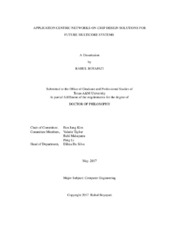| dc.description.abstract | With advances in technology, future multicore systems scaled to 100s and 1000s of cores/accelerators are being touted as an effective solution for extracting huge performance gains using parallel programming paradigms. However with the failure of Dennard Scaling all the components on the chip cannot be run simultaneously without breaking the power and thermal constraints leading to strict chip power envelops. The scaling up of the number of on chip components has also brought upon Networks-On-Chip (NoC) based interconnect designs like 2D mesh. The contribution of NoC to the total on chip power and overall performance has been increasing steadily and hence high performance power-efficient NoC designs are becoming crucial.
Future multicore paradigms can be broadly classified, based on the applications they are tailored to, into traditional Chip Multi processor(CMP) based application based systems, characterized by low core and NoC utilization, and emerging big data application based systems, characterized by large amounts of data movement necessitating high throughput requirements. To this order, we propose NoC design solutions for power-savings in future CMPs tailored to traditional applications and higher effective throughput gains in multicore systems tailored to bandwidth intensive applications. First, we propose Fly-over, a light-weight distributed mechanism for power-gating routers attached to switched off cores to reduce NoC power consumption in low load CMP environment. Secondly, we plan on utilizing a promising next generation memory technology, Spin-Transfer Torque Magnetic RAM(STT-MRAM), to achieve enhanced NoC performance to satisfy the high throughput demands in emerging bandwidth intensive applications, while reducing the power consumption simultaneously. Thirdly, we present a hardware data approximation framework for NoCs, APPROX-NoC, with an online data error control mechanism, which can leverage the approximate computing paradigm in the emerging data intensive big data applications to attain higher performance per watt. | en |


